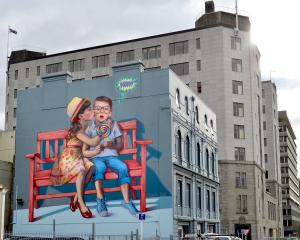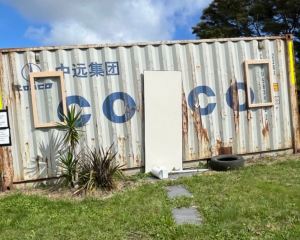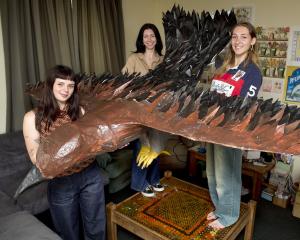The inaugural New Zealand International Early Music Festival begins on Saturday with colourful concert The Tudors: Piety and Pleasure, followed by eight other concerts of baroque, renaissance or medieval music, and closing with a picnic. A concurrent exhibition, ''Plainsong to Pergolesi: A Timeline of Early Music'' is at the Dunedin Public Library until March 10. Charmian Smith talks to harpsichordist Douglas Mews and soprano Lois Johnston about their love of early music.
These days there's a huge distinction between popular and classical music, but a few centuries ago they were not far apart, according to Douglas Mews, Wellington organist and harpsichordist. He is giving two concerts, one a solo recital, as part of the inaugural New Zealand International Early Music Festival, which starts on Saturday.''
I feel classical music has come to a point where it's very hard to go further. We've developed instruments to their extremes and compositions to their extreme - where can we go?'' he said.
''For me the interesting direction is to go backwards and rediscover these old pieces of music. When I say it's more natural, it's not that later music is unnatural but I guess it's music that resonates with the natural world.''
Mews was introduced to the art of playing authentic period instruments with a knowledge of period style when he was a student at Auckland University in the 1970s by the late Anthony Jennings. He went on to study harpsichord in Holland and also became interested in playing the fortepiano, the forerunner of the modern piano, which began to supplant the harpsichord in the late 18th century. Most of the authentic instruments played these days are copies of originals in museums or other collections, he says.
''The instrument basically tells you a lot about the composer and what he wrote - it's like another teacher really, to have an instrument of the period.''
Because the strings on a harpsichord are plucked rather than struck as on pianos, you cannot play loudly or softly, so you have to use other means to make the music expressive, he says.
''You work through what people wrote about harpsichord playing back then and you try things and you realise that what was important was how you use your fingers, how long you leave a note down for and how you might subtly change the rhythm. All these aspects that aren't important with the piano suddenly become much more important so you end up developing an expressive style that doesn't depend on being able to play loud and soft.''
When playing a Bach fugue on the piano, for example, the normal practice is to bring out the theme by making it louder but on the harpsichord you are forced to treat all the parts equally and let them come out the way they are written, Mews said.
''The tone of the harpsichord is much thinner so it's possible to hear all four voices or parts, and according to how busy one part is, it will come out or not. The idea is that all the voices are on an equal footing and the composer makes it clear what's going to be heard. It's a different way of thinking.''
There's also an improvisatory element in baroque music, especially in the figured bass, which is a bass line with a shorthand accompaniment noted only in numerals and symbols.
''The normal accompaniment on harpsichord or on the lute was to a great extent improvised. The only thing that was not improvised was the actual bass line that might also be played by a cello or bassoon. The left-hand bass line is written out but what you do with your right hand is definitely up to you,'' Mews said.''
Sometimes the composer will write some figures but not always and it really depends on how fussy he was. I've found that if he was very fussy and wrote all the figures you need and you play exactly what was there it probably won't sound as good because it lacks that improvisatory quality. It's not much different from jazz and pop where you don't have everything written out,'' he said.
''It gets back to why I like earlier music; it has that freedom. It's good to get a little of that improvisation back, which we have gradually lost.''
In his harpsichord recital featuring French harpsichord music on Tuesday, Mews will play suites by Francois Couperin (1688-1733) and Jean-Philippe Rameau (1683-1764), many of them featuring dance music.
''The French were the masters of dance so it's no surprise that a lot of French music is based on dance forms, and often those dances came from the countryside, like the Tambourin, a dance from Provence.''
Tombeau de Monsieur Blancrocher by J.J. Froberger (1616-1667 ) is an elegy (tombeau means tomb) for a M. Blancrocher, a lutenist who fell down stairs during a party attended by a lot of musicians. Two of them wrote tombeaux for him.''
The piece is in a style that makes you think of the lute and it also paints a bit of a picture. You get a picture of Blancrocher falling down the stairs or being lowered into the ground in a coffin, and someone has even said maybe that's him going to hell; it's the way the piece ends on a downward scale.
You also hear the tolling bell. There are lots of more interesting things happening too in a quasi-improvisatory style.
''The fourth work he will play is from the revolutionary period, the very end of the Baroque in the 1790s, he said. It's variations on La Marseillaise, the revolutionary French national anthem.''
The composer Balbastre [1742-1799] was a harpsichordist and organist. In order partly to save his skin and partly to save the instruments he was playing - organs had all that lead in them which was needed for musket balls - he immediately put himself on the revolutionary side and played La Marseillaise on the big organ in churches to show his allegiance and to stop the soldiers tearing the organ down. He composed this piece and described himself as a citizen of the Republic. He many have just been protecting himself and his instruments but at least it meant the instruments did survive so we have them now,'' Mews said with a laugh.
New Zealand International Early Music Festival
• Douglas Mews' harpsichord recital, Vive la France! Great Masters of the French Harpsichord, is on Tuesday, March 4 at 1pm in St Paul's Cathedral.
Purcell and Handel: The Genii of their Ages with Lois Johnston (soprano), Christopher John Clifford (countertenor), Tomas Hurnik (cello) and Douglas Mews (harpsichord) is on Wednesday, March 5 at 8.30pm in All Saints Church.
Other concerts and recitals are:
• The Tudors: Piety and Pleasure The Southern Consort of Voices, The Rare Byrds and Les Belles Vilaines on Saturday, March 1 at 7pm in St Paul's Cathedral. This concert celebrates the splendors of 16th-century English Renaissance music. In the first half of the concert, the Southern Concert of Voices sings a selection of sacred music by Tallis and Byrd. In the second half, the Rare Byrds present a bird's-eye view of the Tudor monarchs in poetry, Elizabethan song, and dance music. They will be joined by Les Belles Vilaines who will perform dances of the era.
• Guillaume de Machaut: Messe de Nostre Dame (after 1365) The St Paul's Cathedral Choir, directed by George Chittenden, on Sunday, March 2 at 10am in St Paul's Cathedral.
• From Court to Cathedral: Early Spanish Organ Music
Alan Edwards (Dunedin), organ, Monday, March 3, at 1pm in St Paul's Cathedral.
• Caravaggio's Lute: Lute Music in Rome c.1600
John Griffiths on lute, Wednesday, March 5 at 1pm in All Saints Church.
• Fantasies and Sighs: Intimate Vihuela Music from Renaissance Spain
John Griffiths on vihuela, an early form of guitar, Thursday, March 6 at 7pm in All Saints Church.
• Baroque German Masters of the Organ: Bach, Pachelbel and Buxtehude
• David Burchell on organ on Friday, March 7 at 1pm in All Saints Church.
The St Paul's Cathedral Choir, directed by George Chittenden sing Plainchant: Processional, Purcell: Anthem, Gregorio Allegri: Miserere mei, Deus, and Carlo di Gesualdo: Tenebrae Responsoria (1611) for Holy Saturday on Saturday, March 8 at 7pm in St Paul's Cathedral.
• The festival concludes with a Renaissance-themed picnic at the former Catholic Church in Seacliff on Sunday, March 9 from noon to 4pm.












